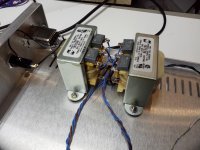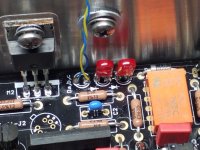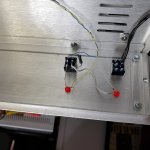Looking good. Congratulations.
Your bringing one of the muting circuit's Leds to the front is a valid move. I actually had also mentioned that option in the past. Shows ready status beyond the relay click's aural clue if valuable. With the additional switch in its way you control the muting manually of course. Because it breaks the relay's power line. Another additional feature.
*I explained not for you, you know why you added those features, but for all to know their meaning with the opportunity of your build's example.
Let us know how you will like it.
Your bringing one of the muting circuit's Leds to the front is a valid move. I actually had also mentioned that option in the past. Shows ready status beyond the relay click's aural clue if valuable. With the additional switch in its way you control the muting manually of course. Because it breaks the relay's power line. Another additional feature.
*I explained not for you, you know why you added those features, but for all to know their meaning with the opportunity of your build's example.
Let us know how you will like it.
The case is a Par-metal 20-16123 . I am very happy with this case and cannot believe how much case I got for $80 USD. The stepped attenuator is a Allo Ladder type 10K, and for $29 is a bargain. The down side of a 10K attenuator is the load it presents to the source. The input selector came from Tubecad and is a Select2 model which mated to the coax cable well. I have a few things to do today and the I will give it a listen.
Thanks for the details. By the way, did you snubb the Hammond trafos with a Quasimodo, or approximately?
I used my quasimodo on the Hammond 187e36 transformers and came up with 165 ohms for the snubber resistors. The nice thing about the transformers is the connection tabs allowed me to place the snubber on the transformer
I used wire wrap wire to connect the front panel LED Da on the board , I also tied a wire to the ground side of Rb. This allows me to get power to a LED for a power indicator.
Attachments
Last edited:
By the way, was it easy with the PF5102/J113 substitution in your DCSTB (IDSS range? Rsource (R1,R2) value?), and what type Q1 Q2 in the DCG3 you opted for?
I did not get my shipment of J113 so I used what I had on hand. BF245 selected for IDSS of 5 ma. I used 1 ohm resistors for R1 and R2. The pinout is different but no big deal. Works just fine
Hooked it up and woha , bass , lots of bass. My subs go down to 20hz so the difference between my capacitor coupled B1 buffer and the DCG3 is quite pronounced. Good imaging, dual mono power supply , looking good. I will need to do some more listening.
They are nice too, maybe more sparkly than finer & deeper, but they could be lending better to counterpointing some subs. Anyways, it will need to play little few hours for the Pana FCs to fully come up from storage life.
I have had some time to listen to this preamp and I must say, I think it will be around for a long time. The sound just flows effortlessly, the sound stage is excellent . I hear more of the room , percussion is clean . I am driving 20 feet of Beldin coax with no problem. Now I need to build a nice phono preamp.
My thanks to Salas for a great design and to Teabag for those hard to get parts
My thanks to Salas for a great design and to Teabag for those hard to get parts
I have had some time to listen to this preamp and I must say, I think it will be around for a long time. The sound just flows effortlessly, the sound stage is excellent . I hear more of the room , percussion is clean . I am driving 20 feet of Beldin coax with no problem. Now I need to build a nice phono preamp.
My thanks to Salas for a great design and to Teabag for those hard to get parts
For phono, you can' t go wrong with : Simplistic NJFET RIAA
- Home
- Source & Line
- Analog Line Level
- Salas DCG3 preamp (line & headphone)



